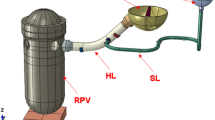Abstract
The main purpose of this paper is to establish the high temperature structural integrity evaluating procedures for the next generation reactors, which are to be operated at over 500°C and for 60 years. To do this, comparison studies of the high temperature structural design codes and assessment procedures such as the ASME-NH (USA), RCC-MR (France), DDS (Japan), and R5 (UK) are carried out in view of the accumulated inelastic strain and the creep-fatigue damage evaluations. Also the application procedures of the ASME-NH rules with the actual thermal and structural analysis results are described in detail. To overcome the complexity and the engineering costs arising from a real application of the ASME-NH rules by hand, all the procedures established in this study such as the time-dependent primary stress limits, total accumulated creep ratcheting strain limits, and the creep-fatigue damage limits are computerized and implemented into the SIE ASME-NH program. Using this program, the selected high temperature structures subjected to two cycle types are evaluated and the parametric studies for the effects of the time step size, primary load, number of cycles, normal temperature for the creep damage evaluations and the effects of the load history on the creep ratcheting strain calculations are investigated.
Similar content being viewed by others
Abbreviations
- j:
-
j-th cycle type
- Kt :
-
Bending stress reduction factor due to creep
- Kε, K’e :
-
Strain concentration factor
- K, KL, KT :
-
Stress concentration factor
- Kv :
-
Multiaxial plasticity and Poisson ratio adjustment factor
- N:
-
Number of cycle type
- P1 :
-
Effective primary membrane stress intensity
- P3 :
-
Effective primary stress intensity with creep effect
- Pb :
-
Primary bending stress intensity
- PL :
-
Local primary membrane stress intensity
- Pm :
-
Primary membrane stress intensity
- (QR) max:
-
The maximum range of the secondary stress intensity
- S*,S :
-
Stress indicators
- Sy :
-
Averaged yield stress for the max. and the min. temp.
- Sa :
-
Min [1.25St¦Tmax,104hr, averaged Sy]
- t:
-
Time
- T:
-
Temperature
- V:
-
Efficiency index
- X, Y:
-
Stress parameters
- εp :
-
Plastic strain
- εc :
-
Creep strain
- εec :
-
Enhanced creep strain
- εmR :
-
Ratchet strain (membrane)
- εbR :
-
Ratchet strain (bending)
- εmEF :
-
Elastic followup strain by long term secondary bending stress (membrane)
- εbEF :
-
Elastic followup strain by long term secondary bending stress (bending)
- εt :
-
Total strain range
- σb :
-
Corrected primary bending stress intensity
- σc :
-
Effective creep stress
- σL :
-
Corrected local primary membrane stress intensity
- σm :
-
Corrected primary membrane stress intensity
- Φ:
-
Bending stress reduction factor due to creep
References
1984, Elevated Temperature Structural Design Guide for Class 1 Components of Prototype Fast Breeder Reactor, PNC N241-84-08, PNC.
1987, 1993, 2002 RCC-MR, Design and Construction Rules for Mechanical Components of FBR Nuclear Islands, AFCEN.
2003, Assessment Procedure for the High Temperature Response of Structures, British Energy Generation Ltd.
2004, ASME Boiler and Pressure Vessel Code Section III, Subsection NH, ASME.
ANSYS User’s Manual, Volume I and II.
Bree, J., 1967, “Elastic-Plastic Behavior of Thin Tubes Subjected to Internal Pressure and Intermittent High-Heat Fluxes with Application to Fast-Nuclear-Reactor Fuel Elements,”Journal of Strain Analysis, Vol. 2, pp. 226–238.
Koo, G. H. and Yoo, B., 2000, “Elevated Temperature Design of KALIMER Reactor Internals Accounting for Creep and Stress Rupture Effects,”Journal of the Korean Nuclear Society, Vol. 32, No. 6, pp. 566–594.
Koo, G. H. and Yoo, B., 2001, “Evaluation of Creep-Fatigue Damage of KALIMER Reactor Internals Using the Elastic Analysis Method in RCC-MR,”Journal of the Korean Nuclear Society, Vol. 33, No. 6, pp. 566–594.
Koo, G. H. and Lee, J. H., 2006, Computer Program of SIE ASME-NH Code, KAERI/TR-3161/2006, KAERI.
Penny, S. K., 1962, A Fortran Subroutine for Table Generation by Data Interpolation, Oak Ridge national Laboratory, ORNL-3255.
Shah, V. N., Majumdar, S. and Natesan, K., 2003, Review and Assessment of Codes and Procedures for HTGR Components, NUREG/CR-6816, ANL-02/36, Argonne National Laboratory.
Author information
Authors and Affiliations
Corresponding author
Rights and permissions
About this article
Cite this article
Koo, GH., Lee, JH. High temperature structural integrity evaluation method and application studies by ASME-NH for the next generation reactor design. J Mech Sci Technol 20, 2061–2078 (2006). https://doi.org/10.1007/BF02916323
Received:
Revised:
Issue Date:
DOI: https://doi.org/10.1007/BF02916323




